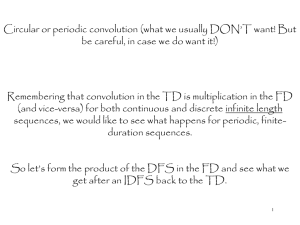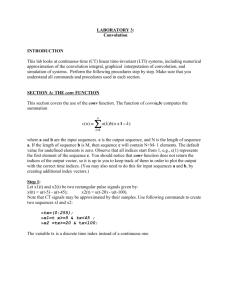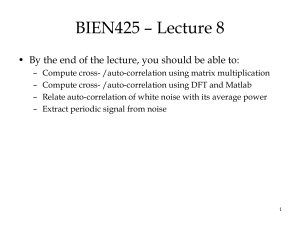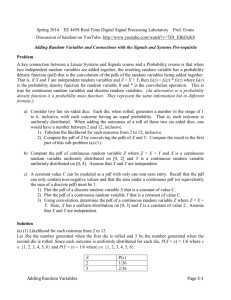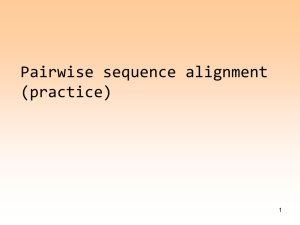Lab DSP02 - Department of Computer Engineering
advertisement
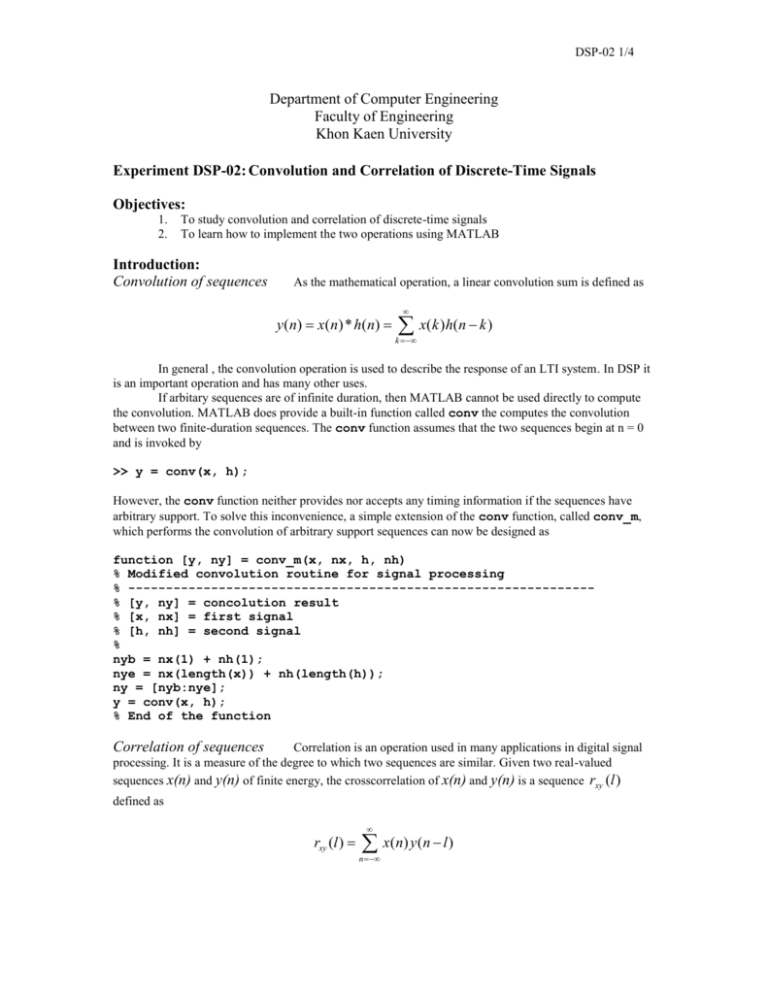
DSP-02 1/4 Department of Computer Engineering Faculty of Engineering Khon Kaen University Experiment DSP-02: Convolution and Correlation of Discrete-Time Signals Objectives: 1. 2. To study convolution and correlation of discrete-time signals To learn how to implement the two operations using MATLAB Introduction: Convolution of sequences As the mathematical operation, a linear convolution sum is defined as y ( n) x ( n) * h( n) x ( k ) h( n k ) k In general , the convolution operation is used to describe the response of an LTI system. In DSP it is an important operation and has many other uses. If arbitary sequences are of infinite duration, then MATLAB cannot be used directly to compute the convolution. MATLAB does provide a built-in function called conv the computes the convolution between two finite-duration sequences. The conv function assumes that the two sequences begin at n = 0 and is invoked by >> y = conv(x, h); However, the conv function neither provides nor accepts any timing information if the sequences have arbitrary support. To solve this inconvenience, a simple extension of the conv function, called conv_m, which performs the convolution of arbitrary support sequences can now be designed as function [y, ny] = conv_m(x, nx, h, nh) % Modified convolution routine for signal processing % -------------------------------------------------------------% [y, ny] = concolution result % [x, nx] = first signal % [h, nh] = second signal % nyb = nx(1) + nh(1); nye = nx(length(x)) + nh(length(h)); ny = [nyb:nye]; y = conv(x, h); % End of the function Correlation of sequences Correlation is an operation used in many applications in digital signal processing. It is a measure of the degree to which two sequences are similar. Given two real-valued sequences x(n) and y(n) of finite energy, the crosscorrelation of x(n) and y(n) is a sequence rxy (l ) defined as rxy (l ) x ( n) y ( n l ) n DSP-02 2/4 The index l is called the shift or lag parameter. The special case when y (n) x(n) is called autocorrelation and is defined by rxx (l ) x ( n) x ( n l ) n If we compare the convolution operation with the crosscorrelation of two sequences, we observe a close resemblance. The crosscorrelation rxy (l ) can be put in the form rxy (l ) x(l ) y (l ) with the autocorrelation rxx (l ) in the form rxx (l ) x(l ) x(l ) Therefore these correlations can be computed using the conv function if sequences are of finite duration. The signal-processing toolbox MATLAB provides a function called xcorr for sequence correlation computations. However, the function does not provide the timing (or lag) information, which then must be obtained by some other means. Experiment: ( Before starting the lab, you’re supposed to have all functions from DSP-01 stored in your working folder.) A. Convolution of Sequences Given the following two sequences x1(n) = [ 0, 0, 1, 1, 1, 1, 1] and 1. 2. For –10 k 10, plot x1(k) and x2(k) using the stem function. Plot x1(k) and x2(-k) and then with a loop control structure, write a program to determine 10 y(0) = k 10 3. x2(n) =[0, 0, 0, 1, 1, 1] x1 (k ) x2 ( k ) Plot x1(k) and x2(1-k) and then, with a loop control structure, write a program to determine 10 y(1) = x (k ) x (1 k ) k 10 4. 1 2 Plot x1(k) and x2(-1-k) and then with a loop control structure, write a program to determine 10 y(-1) = x (k ) x (1 k ) k 10 5. 1 2 Develop a program to determine y (n) x1 (n) * x2 (n) x (k ) x (n k ) k 1 2 15 n 15 DSP-02 3/4 6. 7. 8. For –15 n 15, plot the sequence y(n) obtained in (5). What are the beginning point and end point of y(n) that are non-zero values? Invoke the following MATLAB commands and plot the result (y versus ny) >> x1 = [0, 0, 1, 1, 1, 1, 1]; nx1 = [-3:3]; >> x2 = [0, 0, 0, 1, 1, 1]; nx2 = [-3:2]; >> [y, ny] = conv_m(x1, nx1, x2, nx2); Compare the plot in (7) to the plot in (6). Briefly explain what you get. B. Correlation of Sequences 1. 2. Create a MATLAB function called xcorr_m to perform the correlation operation based on the convolution operation. Let x(n) = [3, 11, 7, 0, -1, 4, 2] be a prototype sequence and y(n) = x(n-2)+w(n) be its noise-corrupted and shifted version. Write the following code and save as a M-file. % noise sequence 1 x =[3, 11, 7, 0, -1, 4, 2]; nx = [-3:3]; % given siganl x(n) [y, ny] = sigshift(x, nx, 2); % obtain x(n-2) w = randn(1, length(y)); nw= ny; % generate w(n) [y, ny] = sigadd(y, ny, w, nw); % obtain y(n) = x(n-2) + w(n) [rxy, nrxy] = xcorr_m(x, nx, y, ny); % crosscorrelation subplot(2, 1, 1); stem(nrxy, rxy); axis([-5, 10, -50, 250]); xlabel(‘lag variable l’); ylabel(‘rxy’); title(‘Crosscorrelation: noise sequence 1’); % % noise sequence 2 x =[3, 11, 7, 0, -1, 4, 2]; nx = [-3:3]; % given siganl x(n) [y, ny] = sigshift(x, nx, 2); % obtain x(n-2) w = randn(1, length(y)); nw = ny; % generate w(n) [y, ny] = sigadd(y, ny, w, nw); % obtain y(n) = x(n-2) + w(n) [rxy, nrxy] = xcorr_m(x, nx, y, ny); % crosscorrelation subplot(2, 1, 2); stem(nrxy, rxy); axis([-5, 10, -50, 250]); xlabel(‘lag variable l’); ylabel(‘rxy’); title(‘Crosscorrelation: noise sequence 2’); 3. Run the script saved in (2) and print the output figure. Questions: 1. Determine if the result sequences from A.6 and A.7 are identical or not. Explain. 2. Let 3. the beginning and end point of y (n) x(n) h(n) . From the result in B.3, what is the value of l that the crosscorrelation got peak? What would it imply? x(n); nxb n nxe and h(n); nhb n nhe be two finite-duration sequences. Determine Nawapak Eua-anant and Rujchai Ung-arunyawee 15 November 2548 DSP-02 4/4 Name:______________________________________________________________ID:________________ In class assignment 1. Explain, step by step, the method to perform the convolution between 2 signals that you use in part A of this experiment. 2. What knowledge do you get from this lab?
